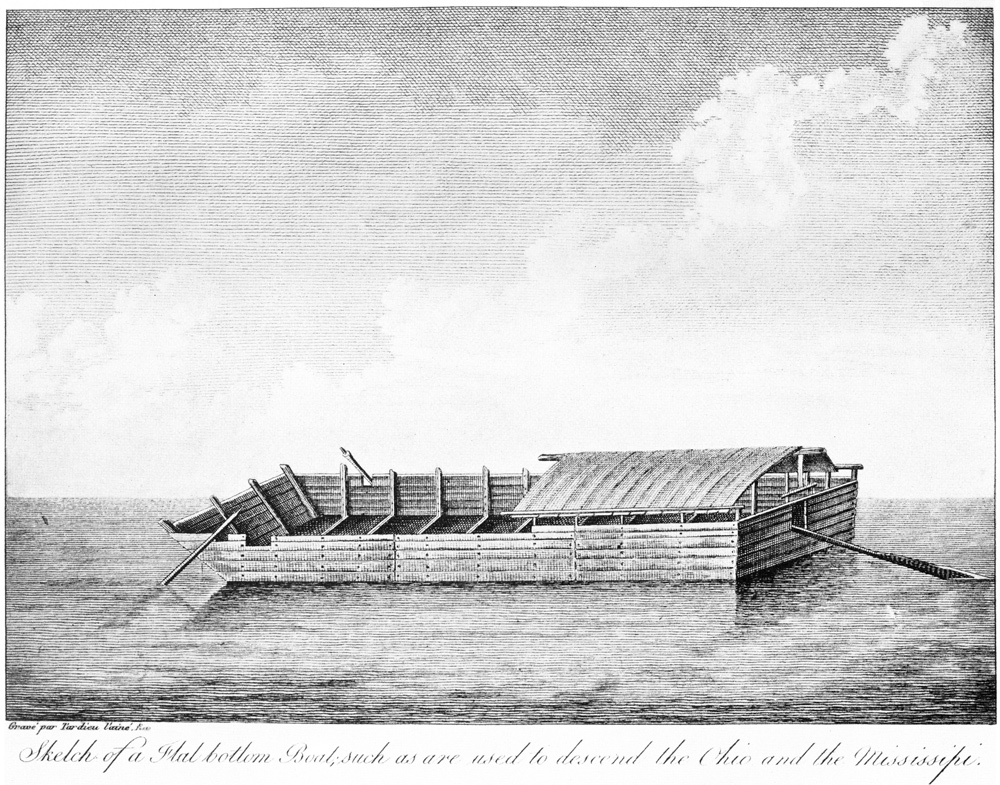Pittsburgh, PA As the barge nears completion, Lewis prepares for departure down the Ohio River. Here, Ohio River commerce via flatboats is described by other travelers.
Flat-bottomed Boat
by Victor Collot (1750–1805) and Joseph Warin (unknown–1796).
Engraved by Tardieu L’Ainé. From Collot, Voyage Dans L’Amérique Septentrionale, Plate 7. Courtesy Bibliothèque nationale de France, catalogue.bnf.fr/ark:/12148/cb407746927.
Image text: Sketch of a Flat bottom Boat such as are used to descend the Ohio and the Mississipi.
Ohio River Commerce
Most of the articles of merchandize brought in waggons over the mountains in the summer season, and destined for the trade down the river, are stored at this place, to be ready for embarkation. With those a great many trading boats are laden, which float down the river, stopping at the towns on its banks to vend the articles. In a country, so remote from commerce, and of so great extent, where each one resides on his own farm, and has neither opportunity nor convenience for visiting a market, these trading boats contribute very much to the accommodation of life, by bringing to every man’s house those little necessaries which it would be very troublesome to go a great distance to procure.
—Thaddeus Harris[1]Thaddeus Harris, The Journal of a Tour into the Territory Northwest of the Alleghany Mountains Made in the Spring of the Year 1803, p. 42–43 in Reuben G. Thwaites, Travels West of the Alleghanies … Continue reading
Collot’s Flat-bottomed Boats
It is on its shores that most of the flat boats, intended to carry emigrants to Kentucky, are built, and even those with keels for the Mississippi; the first, called Kentucky’s-Boats, have the form of a large long square [See Figure] varying in its proportions from thirty to fifty feet in length, and from twelve to twenty in breadth, but never less than four in depth. All these boats are built without nails, which makes them quite dangerous for the Mississippi, in which a very large quantity is lost by the damage they experience at the slightest shock, either against rocks or against large trees. with which this river is encumbered, and by the difficulty of governing them.[2]Victor Collot, Voyage Dans L’Amérique Septentrionale ou Description des pays Arrosés par le Mississipi, L’Ohio, Le Missouri et Autres Rivièrs Affluentes . . . . (Paris: Arthus … Continue reading
Notes
| ↑1 | Thaddeus Harris, The Journal of a Tour into the Territory Northwest of the Alleghany Mountains Made in the Spring of the Year 1803, p. 42–43 in Reuben G. Thwaites, Travels West of the Alleghanies (Cleveland: The Arthur H. Clark Co., 1904), p. 343–4. |
|---|---|
| ↑2 | Victor Collot, Voyage Dans L’Amérique Septentrionale ou Description des pays Arrosés par le Mississipi, L’Ohio, Le Missouri et Autres Rivièrs Affluentes . . . . (Paris: Arthus Bertrand, 1826), 1:51-2 translated from the original French by Google Translate. |

